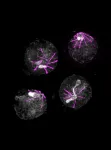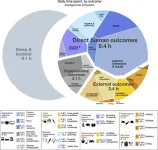(Press-News.org) As a part of its life cycle, the human immunodeficiency virus-1 (HIV) inserts a copy of its DNA into human immune cells. Some of these newly infected immune cells can then transition into a dormant, latent state for a long period of time, which is referred to as HIV latency.
Although current therapies, such current antiretroviral therapy (ART), can successfully block the virus from replicating further, it cannot eradicate latent HIV. If treatment is ever discontinued, the virus can rebound from latency and reignite the progression of HIV infection to AIDS.
Scientists from the HIV Cure Center at the UNC School of Medicine, University of California San Diego, Emory University, and University of Pennsylvania have been searching for where exactly these latent cells are hiding in the body. New research published in the Journal of Clinical Investigations confirms that microglial cells – which are specialized immune cells with a decade-long lifespan in the brain – can serve as a stable viral reservoir for latent HIV.
“We now know that microglial cells serve as a persistent brain reservoir,” said first author Yuyang Tang, PhD, assistant professor of medicine in the Division of Infectious Diseases and member of the UNC HIV Cure Center. “This had been suspected in the past, but proof in humans was lacking. Our method for isolating viable brain cells provides a new framework for future studies on reservoirs of the central nervous system, and, ultimately, efforts towards the eradication of HIV.”
Latent HIV
HIV is a tricky and unique virus to study. During infection, the virus specifically targets the key coordinators of the immune response, which are called CD4+ lymphocytes. Over time, the virus kills enough CD4+ cells to cause immunodeficiency. .
Past research has shown that latent HIV can hide within a few of the surviving CD4+ T cells throughout the body and the bloodstream. However, other viral reservoirs have been suspected to hide within the central nervous system (CNS) in people with HIV receiving effective ART.
Unlike peripheral blood cells, it is extremely difficult to access and analyze brain tissues for the study of HIV reservoirs. Since these types of cells cannot be safely sampled in people taking ART, the potential viral reservoir in the brain has remained an enigma for many years.
Extracting Pure Brain Tissue
The team first studied the brains of macaques with the simian immunodeficiency virus (SIV), a virus that is closely related to HIV, from the Yerkes National Primate Research Center at Emory University to get a better understanding of how to extract and purify viable cells from primate brain tissue.
Researchers used physical separation techniques and antibodies to selectively remove cells that were expressing microglial surface markers. Then, they isolated and separated the highly pure brain myeloid cells from the CD4+ cells that were passing through the brain tissue.
Using these techniques, researchers then obtained samples that were donated by HIV+ people who were enrolled in “The Last Gift” Study at the University of California San Diego (UCSD). As a part of this unique and important effort, altruistic HIV+ people, who are taking ART but suffering from other terminal illnesses, will their bodies to further the HIV research project.
“The samples are from people living with HIV, who are on therapy but facing a fatal disease of some kind,” said the co-author David Margolis, MD, the Sarah Kenan Distinguished Professor of Medicine, Microbiology & Immunology, and Epidemiology. “They were willing to not just donate their bodies to science, but also participate in the research program in the months leading up to their death. It’s an extraordinary program that made this critical research possible.”
Future Projects
Now that the researchers know that latent HIV can take refuge in microglial cells in the brain, they are now considering plans to target this type of reservoir. Since latent HIV in the brain is radically different from the virus in the periphery, researchers believe that it has adapted special characteristics to replicate in the brain.
“HIV is very smart,” said senior author Guochun Jiang, PhD, assistant professor in the UNC Department of Biochemistry and Biophysics and member of the UNC HIV Cure Center. “Over time, it has evolved to have epigenetic control of its expression, silencing the virus to hide in the brain from immune clearance. We are starting to unravel the unique mechanism that allows latency of HIV in brain microglia”.”
NF-κB signaling is one of the critical signaling pathways that controls HIV expression elsewhere in the body. When NF-κB signaling is ”turned off”, HIV enters latency in the peripheral blood. However, latent HIV in the brain is not impacted by the activation of NF-κB signaling. Researchers are unsure why that is, but once an answer is found, they will be one step closer to knowing how to selectively target and eradicate the virus in the brain or peripheral blood.In addition to understanding the inner workings of the brain reservoir, the researchers are also trying to determine the true size of the latent HIV brain reservoir.
“It is very hard to know how big the reservoir is,” said Margolis, who is also the director of the UNC HIV Cure Center. “The problem with trying to eradicate HIV is like trying to eradicate cancer. You want to be able to get it all, so it won’t come back.”
END
New research shows HIV can lie dormant in the brain
Researchers in the UNC School of Medicine extracted living brain tissue to conclude that specialized immune cells in the brain can harbor latent but replication-competent HIV.
2023-06-16
ELSE PRESS RELEASES FROM THIS DATE:
For resistant breast cancers, two drugs may be better than one
2023-06-16
Cancer cells are even smarter than scientists previously believed, according to new CU Boulder research. When these cells are confronted with potent new drugs called CDK2 inhibitors, which are designed to prevent cancer from proliferating, they can trigger a workaround to survive the assault in as little as one to two hours.
But the study, published June 8 in the journal “Cell,” comes with a silver lining.
It reveals how cancer cells complete this adaption and shows that simultaneously administering a second, already widely ...
UMass Amherst biostatistician developing statistical tools to predict breast cancer survival and inform targeted therapies
2023-06-16
Breast cancer is a complex disease, and its progression is difficult, yet important, to predict.
While many elements may contribute to a breast cancer prognosis, University of Massachusetts Amherst biostatistician Chi Hyun Lee has zeroed in on one risk factor that has emerged for its potential to predict the disease’s progression.
Lee will use a two-year, $154,791 grant from the National Institutes of Health (NIH) in an effort to develop statistical tools that will better predict breast cancer survival rates and survival time after breast cancer recurrence.
While the project focuses on breast cancer research, the proposed statistical ...
Jefferson Lab outreach efforts earn national recognition
2023-06-16
NEWPORT NEWS, VA – When the global pandemic put the kibosh on in-person events, the U.S. Department of Energy’s Thomas Jefferson National Accelerator Facility sought alternatives for ensuring its world-class science and unique equipment remained accessible. These efforts culminated in the Fall for Science Virtual Field Trip Event, which rolled out a virtual tour experience, new website, and unique supporting materials. Now, the event has been recognized by the Public Relations Society of America with three Anvil Awards.
According ...
Uncovering a cellular process that leads to inflammation
2023-06-16
Cedars-Sinai investigators have identified several steps in a cellular process responsible for triggering one of the body’s important inflammatory responses. Their findings, published in the peer-reviewed journal Science Immunology, open up possibilities for modulating the type of inflammation associated with several infections and inflammatory diseases.
Specifically, the investigators have improved understanding of the steps that lead to the production of IL-1 beta, a potent inflammatory protein signal released during many inflammatory responses.
“We now have a clearer understanding of the stepwise process that leads to the production of IL-1 beta,” said Andrea ...
New imaging technique is no last resort
2023-06-16
There are various ways to image biological samples on a microscopic level, and each has its own pros and cons. For the first time, a team of researchers, including those from the University of Tokyo, has combined aspects from two of the leading imaging techniques to craft a new method of imaging and analyzing biological samples. Its concept, known as RESORT, paves the way to observe living systems in unprecedented detail.
For as long as humanity has been able to manipulate glass, we have used optical devices to peer at the microscopic world in ever increasing ...
Abnormalities in neurodevelopment could lay the foundations for Alzheimer’s disease
2023-06-16
In the cerebral cortex, neurogenesis – the formation of neural cells from stem cells – begins in the fetus from 5 weeks gestation and is almost complete by 28 weeks. It is a complex process with finely tuned mechanisms. “In humans, neurogenesis lasts particularly long compared with other species, explains Khadijeh Shabani, a post-doctoral researcher at Paris Brain Institute. Neural stem cells remain in a progenitor state for an extended period. Only later do they differentiate into glial cells, astrocytes, or oligodendrocytes that will form the architecture of the brain and spinal cord.”
Until ...
Disorient the malaria parasite to prevent it from causing harm
2023-06-16
With almost 250 million cases a year, 621,000 of them fatal, malaria remains a major public health problem, particularly in sub-Saharan Africa. Malaria is a parasitic disease transmitted by mosquitoes and caused by a microbe of the genus Plasmodium. On its journey from mosquito to human, Plasmodium must adapt to the specificities of the many organs and cells it parasitizes. Microbes do not have sensory organs; instead, they have sensors made of proteins to detect molecules specific to the environments they colonize. While most living organisms share the same types of sensors, Plasmodium is an exception. Biologists at the University of Geneva (UNIGE) have identified a new type ...
Growing number of hypothyroidism patients receiving treatment other than levothyroxine
2023-06-16
The use of thyroid hormones other than the commonly prescribed hormone medicine levothyroxine to treat hypothyroidism, or underactive thyroid, is increasing, according to a study being presented Friday at ENDO 2023, the Endocrine Society’s annual meeting in Chicago, Ill.
“This is significant because the long-term health outcomes of these treatments are not as well known as levothyroxine,” said researcher Matthew Ettleson, M.D., of the University of Chicago in Chicago, Ill.
The thyroid makes the hormones triiodothyronine ...
Prevalence of metabolic associated fatty liver disease is increasing
2023-06-16
CHICAGO—The percent of metabolic associated fatty liver disease (MAFLD), the leading global cause of liver disease, is increasing in U.S. adults, according to a study presented Friday at ENDO 2023, the Endocrine Society’s annual meeting in Chicago, Ill.
Mexican Americans consistently had the highest percentage of MAFLD, especially in 2018, although the prevalence of increase was higher among Whites, the study found.
MAFLD, previously known as non-alcoholic fatty liver disease (NAFLD), is fast becoming the most common indication ...
The global human day – A bird’s eye perspective
2023-06-16
Everyone has 24 hours per day. Across the global population of 8 billion people this adds up to approximately 190 billion human hours per day. How those hours are spent determines the impacts we have on our surroundings as well as how we experience life. To find out how people around the world use their time, a research team led by McGill University has gathered and analyzed information about both economic and non-economic activities in order to estimate, for the first time, what a day in the life of the world looks like.
“At present, we are struggling to come to terms with global challenges, and that calls for fresh perspectives on how the world ...
LAST 30 PRESS RELEASES:
Decoupling the HOR enhancement on PtRu: Dynamically matching interfacial water to reaction coordinates
Sulfur isn’t poisonous when it synergistically acts with phosphine in olefins hydroformylation
URI researchers uncover molecular mechanisms behind speciation in corals
Chitin based carbon aerogel offers a cleaner way to store thermal energy
Tracing hidden sources of nitrate pollution in rapidly changing rural urban landscapes
Viruses on plastic pollution may quietly accelerate the spread of antibiotic resistance
Three UH Rainbow Babies & Children’s faculty elected to prestigious American Pediatric Society
Tunnel resilience models unveiled to aid post-earthquake recovery
Satellite communication systems: the future of 5G/6G connectivity
Space computing power networks: a new frontier for satellite technologies
Experiments advance potential of protein that makes hydrogen sulfide as a therapeutic target for Alzheimer’s disease
Examining private equity’s role in fertility care
Current Molecular Pharmacology achieves a landmark: real-time CiteScore advances to 7.2
Skeletal muscle epigenetic clocks developed using postmortem tissue from an Asian population
Estimating unemployment rates with social media data
Climate policies can backfire by eroding “green” values, study finds
Too much screen time too soon? A*STAR study links infant screen exposure to brain changes and teen anxiety
Global psychiatry mourns Professor Dan Stein, visionary who transformed mental health science across Africa and beyond
KIST develops eco-friendly palladium recovery technology to safeguard resource security
Statins significantly reduce mortality risk for adults with diabetes, regardless of cardiovascular risk
Brain immune cells may drive more damage in females than males with Alzheimer’s
Evidence-based recommendations empower clinicians to manage epilepsy in pregnancy
Fungus turns bark beetles’ defenses against them
There are new antivirals being tested for herpesviruses. Scientists now know how they work
CDI scientist, colleagues author review of global burden of fungus Candida auris
How does stroke influence speech comprehension?
B cells transiently unlock their plasticity, risking lymphoma development
Advanced AI dodel predicts spoken language outcomes in deaf children after cochlear implants
Multimodal imaging-based cerebral blood flow prediction model development in simulated microgravity
Accelerated streaming subgraph matching framework is faster, more robust, and scalable
[Press-News.org] New research shows HIV can lie dormant in the brainResearchers in the UNC School of Medicine extracted living brain tissue to conclude that specialized immune cells in the brain can harbor latent but replication-competent HIV.








